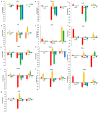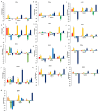Trans-Cinnamaldehyde Primes More Robust Channel Catfish Immune Responses to Edwardsiella ictaluri Infection
- PMID: 38668265
- PMCID: PMC11054112
- DOI: 10.3390/pathogens13040310
Trans-Cinnamaldehyde Primes More Robust Channel Catfish Immune Responses to Edwardsiella ictaluri Infection
Abstract
Infection with Edwardsiella ictaluri, a causative agent of enteric septicemia of catfish, threatens profitable catfish production through inventory losses. We previously demonstrated that trans-cinnamaldehyde (TC) enhances the survival of catfish following E. ictaluri infection. The present study was conducted to investigate catfish immune responses to TC feeding and E. ictaluri infection. The expression of 13 proinflammatory, innate, and adaptive immune-related genes was evaluated over time in two sets of experiments using real-time polymerase chain reaction (PCR). In the first experiment, catfish were fed a basal diet with or without TC supplementation, while in the second they were fed a TC-supplemented or normal diet followed by infection with E. ictaluri. The catfish group infected with E. ictaluri and fed a TC-diet showed significant changes in the expression of innate and adaptive immune-related genes compared to control group. At 21 and 28 days post-infection, recovered fish showed significant increases in the expression of IgM in the anterior kidney and spleen. These results suggest that the supplemental dietary intake of TC can improve the immune status of catfish via engaging innate and adaptive immune responses and the production of memory cells in immunocompetent tissues. Together, this study provides an important foundation for the potential application of TC as an antimicrobial alternative in aquaculture.
Keywords: adaptive immunity; enteric septicemia of catfish; innate immunity; pro-inflammatory genes; real-time PCR.
Conflict of interest statement
The authors declare no conflict of interest.
Figures


Similar articles
-
Synergies between vaccination and dietary arginine and glutamine supplementation improve the immune response of channel catfish against Edwardsiella ictaluri.Fish Shellfish Immunol. 2012 Sep;33(3):543-51. doi: 10.1016/j.fsi.2012.06.005. Epub 2012 Jun 21. Fish Shellfish Immunol. 2012. PMID: 22728565
-
Assessment of the Live Attenuated and Wild-Type Edwardsiella ictaluri-Induced Immune Gene Expression and Langerhans-Like Cell Profiles in the Immune-Related Organs of Catfish.Front Immunol. 2019 Mar 6;10:392. doi: 10.3389/fimmu.2019.00392. eCollection 2019. Front Immunol. 2019. PMID: 30894864 Free PMC article.
-
Adaptive immune responses in channel catfish exposed to Edwardsiella ictaluri live attenuated vaccine and wild type strains through the specific gene expression profiles.Dev Comp Immunol. 2021 Mar;116:103950. doi: 10.1016/j.dci.2020.103950. Epub 2020 Nov 28. Dev Comp Immunol. 2021. PMID: 33253752
-
A comparative study on the immune response in the head and trunk kidney of yellow catfish infected with Edwardsiella ictaluri.Fish Shellfish Immunol. 2024 Nov;154:109895. doi: 10.1016/j.fsi.2024.109895. Epub 2024 Sep 10. Fish Shellfish Immunol. 2024. PMID: 39265963
-
Response of cecropin transgenesis to challenge with Edwardsiella ictaluri in channel catfish Ictalurus punctatus.Fish Shellfish Immunol. 2022 Jul;126:311-317. doi: 10.1016/j.fsi.2022.05.050. Epub 2022 May 27. Fish Shellfish Immunol. 2022. PMID: 35636698 Review.
References
-
- USDA Catfish Production, by the National Agricultural Statistics Service (NASS), Agricultural Statistics Board, United States Department of Agriculture (USDA) 2022. [(accessed on 2 April 2024)]. Available online: https://downloads.usda.library.cornell.edu/usda-esmis/files/bg257f046/gh....
-
- Hemstreet B. An update on Aeromonas hydrophila from a fish health specialist for summer 2010. Catfish J. 2010;24:4.
MeSH terms
Substances
Grants and funding
LinkOut - more resources
Full Text Sources

